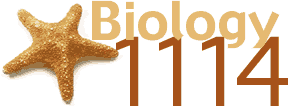
Preview
Material for Exam 3 - Spring 2006
Print
the PDF version (no pictures, better printing)

Preview
Material for Exam 3 - Spring 2006
Print
the PDF version (no pictures, better printing)
G = rN
G = rN(K – N)
K
r = b – d
r = # of births - # of deaths
N
Kyle has a small ranch in
western
On
June 6 at approximately 1:00 p.m., Mrs. Smith, Mrs. Stevenson, and Mrs. Jones
each delivered a healthy baby boy at the
Galactosemia is an autosomal recessive disorder. Babies with galactosemia lack the enzyme that converts galactose (one of two sugars found in lactose) into glucose, a sugar the body is able to use. As a result, milk (including breast milk) and other dairy products must be eliminated from the diet. Otherwise, galactose can build up in the system and damage the body's cells and organs, leading to blindness, severe mental retardation, growth deficiency, and even death.
Couples: |
Blood type |
Galactosemia |
Mr. Stevenson |
B |
No – heterozygous |
Mrs. Stevenson |
B |
No - heterozygous |
Mr. Smith |
A |
Yes |
Mrs. Smith |
O |
No – heterozgyous |
Mr. Jones |
A |
Yes |
Mrs. Jones |
B |
No - homozygous |
Babies: |
||
Baby Larry |
B |
Yes |
Baby Moe |
O |
Yes |
Baby Curly |
A |
No |
A particular herd of Rocky
Mountain Elk in
mRNA-Codon-to-Amino-Acid Decoder
Chart
|
|||||||||
|
|
2nd Letter
|
|
||||||
1st Letter
|
U
|
|
C
|
|
A
|
|
G
|
|
3rd Letter
|
U
|
UUU
UUC
|
Phenylalanine
|
UCU
UCC
UCA
UCG
|
Serine
|
UAU
UAC
|
Tyrosine
|
UGU
UGC
|
Cysteine
|
U
|
C
|
|||||||||
UUA
UUG
|
Leucine
|
UAA
UAG
|
STOP
|
UGA
|
STOP
|
A
|
|||
UGG
|
Tryptophan
|
G
|
|||||||
C
|
CUU
CUC
CUA
CUG
|
Leucine
|
CCU
CCC
CCA
CCG
|
Proline
|
CAU
CAC
|
Histidine
|
CGU
CGC
CGA
CGG
|
Arginine
|
U
|
C
|
|||||||||
CAA
CAG
|
Glutamine
|
A
|
|||||||
G
|
|||||||||
A
|
AUU
AUC
AUA
|
Isoleucine
|
ACU
ACC
ACA
ACG
|
Threonine
|
AAU
AAC
|
Asparagine
|
AGU
AGC
|
Serine
|
U
|
C
|
|||||||||
AAA
AAG
|
Lysine
|
AGA
AGG
|
Arginine
|
A
|
|||||
AUG
|
Methionine START
|
G
|
|||||||
G
|
GUU
GUC
GUA
GUG
|
Valine
|
GCU
GCC
GCA
GCG
|
Alanine
|
GAU
GAC
|
Aspartate
|
GGU
GGC
GGA
GGG
|
Glycine
|
U
|
C
|
|||||||||
GAA
GAG
|
Glutamate
|
A
|
|||||||
G
|
|||||||||
Use the chart and formulas as needed
Hemophilia is an X-linked
recessive trait characterized by the inability to properly form blood
clots. It is often called the “Royal Disease” because it suddenly cropped
up in the children of
The life of a moose begins with a single fertilized egg cell (called a zygote) containing 70 chromosomes. A mature moose is made up of an estimated 500 trillion cells.
Bird flu is a growing concern for health organizations world-wide. It is primarily confined to Asian countries at this time. The disease causing agent (a virus) is easily transmitted from bird to bird; it can also be transmitted from bird to human, but with much lower likelihood. At this time the virus cannot be transmitted from human to human. People have succumbed to the disease only when they have had prolonged direct contact with infected birds, a more common occurrence when large bird and human populations live in close proximity.